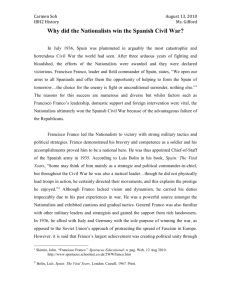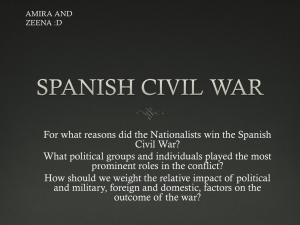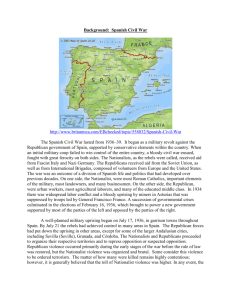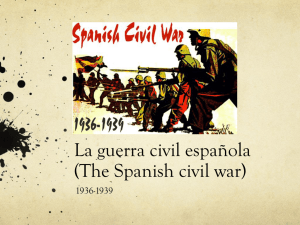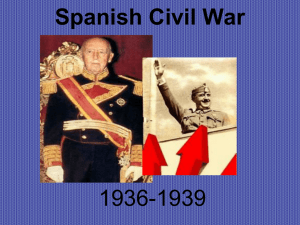The Spanish Civil War
advertisement
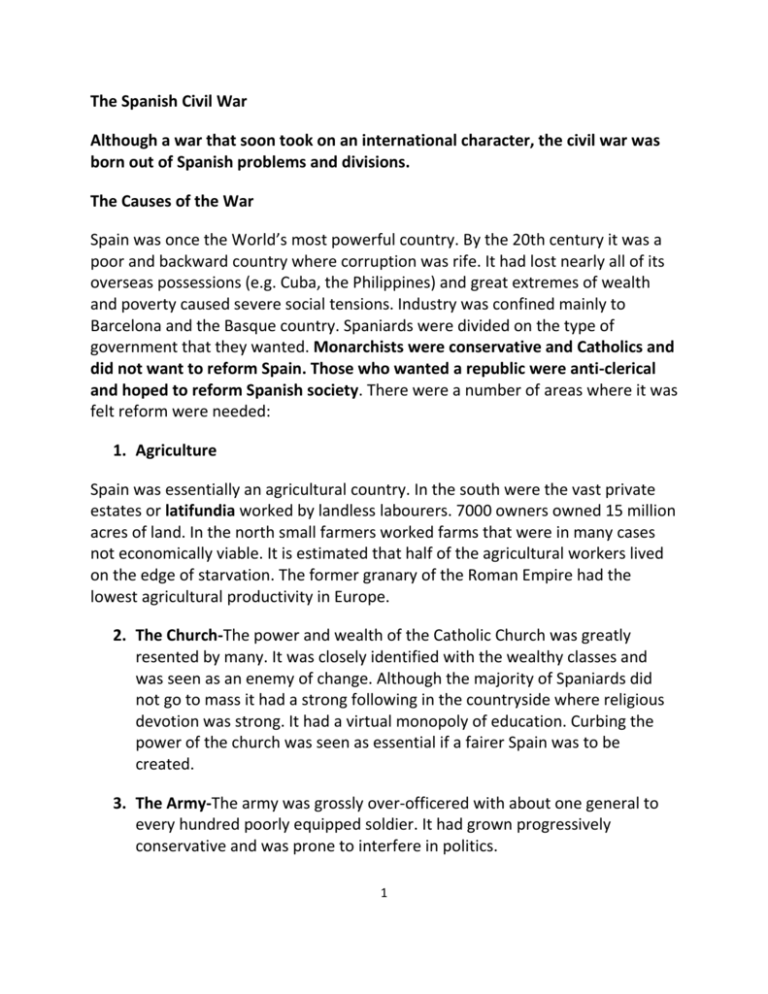
The Spanish Civil War Although a war that soon took on an international character, the civil war was born out of Spanish problems and divisions. The Causes of the War Spain was once the World’s most powerful country. By the 20th century it was a poor and backward country where corruption was rife. It had lost nearly all of its overseas possessions (e.g. Cuba, the Philippines) and great extremes of wealth and poverty caused severe social tensions. Industry was confined mainly to Barcelona and the Basque country. Spaniards were divided on the type of government that they wanted. Monarchists were conservative and Catholics and did not want to reform Spain. Those who wanted a republic were anti-clerical and hoped to reform Spanish society. There were a number of areas where it was felt reform were needed: 1. Agriculture Spain was essentially an agricultural country. In the south were the vast private estates or latifundia worked by landless labourers. 7000 owners owned 15 million acres of land. In the north small farmers worked farms that were in many cases not economically viable. It is estimated that half of the agricultural workers lived on the edge of starvation. The former granary of the Roman Empire had the lowest agricultural productivity in Europe. 2. The Church-The power and wealth of the Catholic Church was greatly resented by many. It was closely identified with the wealthy classes and was seen as an enemy of change. Although the majority of Spaniards did not go to mass it had a strong following in the countryside where religious devotion was strong. It had a virtual monopoly of education. Curbing the power of the church was seen as essential if a fairer Spain was to be created. 3. The Army-The army was grossly over-officered with about one general to every hundred poorly equipped soldier. It had grown progressively conservative and was prone to interfere in politics. 1 4. Regionalism-Spain is a country divided by rivers and mountain ranges with distinct languages and traditions in many areas. Both the Basques and the Catalans wanted to control their own affairs. Republicans sympathised with their demands especially that of the Catalans while conservatives opposed them on the grounds that it would weaken Spain. Primo de Rivera Post-war economic depression led to strikes and unrest and this allied to military defeats in Morocco, led to the emergence of a right-wing military dictatorship underPrimo de Rivera in 1923. At first he was reform minded and brought the socialist leader into his government. The growing unpopularity of the regime forced de Rivera to resign in 1930 after he lost the support of the army. Municipal elections held the following year showed a majority in favour of a republic and King Alfonso XIII abdicated the following year. A republic was declared with Alcala Zamora as provisional prime minister. The Government of 1931-3-The Republican government brought in a series of anti-clerical measures e.g. the Jesuits were dissolved and Church and State were separated. Civil marriage was instituted and divorce was allowed. It granted Catalan autonomy. The government failed to introduce any serious measure of land reform and this weakened its support in the countryside. Thousands of officers were forced to retire on half pay and this caused resentment in the army. A military revolt by General Sanjuro in 1932 was crushed but it showed the deep dissatisfaction in the army with the new republic. The measures against the church alienated the right wing of Spanish society who saw the Catholic Church at the heart of Spanish civilisation. Zamora resigned in protest at the anti-clerical measures. The new prime minister was the anti-clerical liberal, Manuel Azana. The government’s measures led to the foundation of the right-wing and Catholic CEDA party led by Gil Robles. At the same time a fascist party led by the son of Primo de Rivera, Jose Antonio was set up. It was called the Falange (Phalanx). 2 The Government of 1933-6-A right-wing government came to power after the November election in 1933. It reversed the process of reform and cancelled the measures against the Church. The period from 1933 to 1935 became known as the “two black years” by those on the left. In 1934 a general strike was called in opposition to the government and an anarchist miners’ revolt was crushed in Asturias by General Franco. Mass arrests followed and left wing newspapers were closed and the Catalan Autonomy Statute was suspended. Spanish politics had become very polarised. (back) The Countdown to War-In 1936 an election was called. A Popular Front of Communists, Socialists, Republicans and Separatists was formed to oppose the government. The right wing formed the National Front. For the Popular Front the right’s victory would lead straight to fascism; for the National Front, a popular Front victory would lead to “Bolshevik Revolution”. The Popular Front narrowly won the election. Manuel Azana was appointed president and Casares Quiroga became Prime Minister. The new government proceeded to reintroduce the reforms of the 1931-3 government. Disorder and political violence spread throughout the country. Peasants seized land and there were many strikes. The Falange started to grow dramatically as disillusioned supporters of the more moderate CEDA joined its ranks. Its members used political violence and attack and counterattack became common. More seriously the army was plotting to overthrow the new government. The generals were at heart monarchist and were very alarmed at the growing influence of the socialists and anarchists. The leader of the plot was General Mola. On the 13th of July the monarchist politician, Calvo Sotelo was assassinated by Republican police in revenge for the murder of one of their men by a Falangist. The military now had the perfect pretext to make their move. The revolt began on the 17th of July in Spanish Morocco. Supporters of the New Government Opponents of the New Government Popular Front National Front Communists (influential given their support from the USSR.) CEDA led by Gil Robles. This was the largest party in Spain. Socialists led by Largo Caballero. Monarchists supporters of the former king. 3 Liberals (Republican Left Party – led by Manuel Azana , Republican Union) Carlists very conservative and Catholic. Supported a rival claimant to the Spanish throne. Catalans Radical Party small middle class party. Not part of the front but sympathetic Supporters Basques unusual among the republic’s supporters as they were very Catholic. Anarchists (very popular in Spain especially in the poor south). They had boycotted the 1936 election. Its union, the CNT, was the largest in Spain. Far more popular than either the communists or the socialists. The Falange a tiny fascist party that was to grow dramatically after the 1936 election. The Civil War The Nationalists were supported by the Church, army, landowners, and industrialists, some of the middle-class and the Catholic peasantry. Liberals, Socialists, Communists and Anarchists supported the Republicans. 1936 The military hoped to capture Spain in a week but they failed. About half of the army remained loyal to the government and the revolt failed in Madrid, Valencia, Barcelona and the Basque country. Workers and peasants militias were formed to defend the government. Crucially the elite army of Morocco supported the revolt. It was led by General Franco. By August the rebels held most of the North and North West while the government controlled the South and the North Coast. Both sides appealed for foreign aid but fatally for the Republic, the French and the British decided on a policy of non-Intervention. The Germans and the Italians helped the Nationalists while the USSR sent 4 aid to the republicans. German transport planes helped ferry Franco’s army from Morocco to Spain, the first example of direct foreign involvement. The main Nationalist setback was their failure to capture Madrid. Bloody battles were to follow over the next months as the Republicans beat off attempts to encircle Madrid until the Nationalists called off their offensive in November. Communist influence inside the city increased greatly and arrests and summary executions were carried out against suspected Nationalists. In September Nationalists forces captured Toledo and relieved a Nationalist garrison that had held out since the end of July. In September, Largo Caballero became Prime Minister. The Republican government was moved to Valencia in November. In October General Francowas appointed head of the Nationalist government of Spain. Most of the Spanish gold reserves (the fourth largest in the world) were sent to the USSR in exchange for military equipment that began arriving in October. The transfer of the gold led to a dramatic rise in inflation on the republican zone. Foreign volunteers, organised into the International Brigades, started to arrive. 1937 In February the Nationalists began offensives at Jarama and Guadalajara that were aimed at capturing Madrid. Both were stopped with heavy causalities. In March the Nationalists attacked the Basque country and in April the Basque city of Guernica was bombed by the German Condor Legion. Basque morale collapsed and the capital, Bilbao fell in June. The industry of the Basque country was now in Nationalist hands. Also in April Franco merged the Carlists, the Falange and other groups into a 5 single party known as the National Movement. One of the features of the Nationalists from then on was their unity which contrasted with the divisions on the Republican side. In May, the divisions on the Republican side were clearly shown by events in Barcelona. This civil war within a civil war saw the Socialists and Communists fight street battles with the Anarchists and Trotskyites. The former won and a bloody purge was carried out against enemies of the communists. As a result of the events, Negrin replaced Caballero as Prime Minister and in October, the Government moved to Barcelona. From then on the Communists backed by Soviet help were to play an increasing role in all Republican areas of Spain. Their organisation helped to keep the republic fighting. Inspired speeches from Dolores Ibárruri (La Pasionaria) the chief propagandist of the Republic, raised morale. However their extensive use of a brutal secret police (the SIM) and their intolerance of opposition caused many others to wonder if life would not be better under Franco. Republican attempts to stop the capture of Madrid led to the inconclusive battle of Brunete. A further republican offensive at Teruel in December was defeated after bitter fighting. 6 1938 The Nationalists captured the key town of Teruel and in April, they reached the Mediterranean. They now split Republican-held Spain in two and isolated Catalonia. In July, General Modesto launched a Republican offensive at the Ebro River. Initial successes were repulsed by the Nationalists and in November the offensive ended in defeat. In December, the Nationalists began their advance into Catalonia. 1939 After two and a half years of resistance, the Republic collapsed rapidly during the first three months of 1939. In January, the Nationalists occupied Barcelonaand in March they captured Madrid which effectively marked the end of the war. On April 1st, Franco declared the war at an end. About a half a million people were killed in the war with hundreds of thousands dying in atrocities committed by both sides. Most were killed by the Nationalists who were ruthless in establishing control in the areas they captured. For example when they captured Badajoz in August 1936 over 1500 of the towns defenders were shot in batches in the town’s bull ring. In all about 200,000 people were executed by the Nationalists. Republican violence was more spontaneous usually not official policy and directed against landowners, businessmen, the police and especially the church. Their victims numbered about 20,000 although the Communists shot many of their ideological enemies, e.g. Anarchists, in Barcelona and Madrid. Half a million republican refugees fled to France while about 200,000 republican prisoners were executed or died in prison after the war. Some were handed back to Franco when the Germans captured France in 1940. General Franco Born in 1892 in Spain's north-western naval town of Ferrol. In 1907 he entered the Military Academy in Toledo. He was posted to Morocco in 1912. 7 In a savage colonial war, his bravery and competence won him rapid promotions and by 1920, he was a second-in-command of the Foreign Legion. In 1926, he was promoted to Brigadier General, the youngest in Europe. His exploits made him a national hero and a favourite of King Alfonso XIII. Franco opposed the fall of the monarchy on April 14, 1931. Despite his opposition to the new republic he was posted to the Balearic Islands. He was promoted to Major General on in 1934 and in the same year he crushed the miner’s revolt in Asturias. In 1935, he was made commander-in-chief of the Spanish armed forces in Morocco and the same year he became chief-ofstaff of the army. Foreign Involvement The Spanish civil war started as a distinctly Spanish war born out of Spanish disputes but it was soon to take on an international character. It mirrored the political disputes occurring in Europe at the time between Fascism and democracy on one hand and the opposition to godless Communism on the other. Both sides realised the importance of foreign aid and support. Propaganda played a key role. The Nationalists argued that they represented the cause of Christianity, order and Western civilisation against Communism. The Republicans argued that they were the legally elected government of Spain which was under attack from anti-democratic generals and the fascist dictatorships. Germany and Italy sent aid to Franco. German aid totalled about 16,000 men, 200 tanks and 600 planes. Some of the activities of the German Condor Legion especially the bombing of Guernica became infamous but militarily Beevor noted the Condor Legion was “the most efficient and influential assistance in Spain.” 8 Helped by German planes, Nationalist air superiority was crucial to their success during the war. The Germans used Spain as a testing ground for their new planes tanks and for the development of blitzkrieg tactics. Italy sent about 75,000 men, 150 tanks and 660 aircraft and as Beevor wrote “the Italian contribution to the Nationalist cause was enormous and more general than the German contribution. “This included a major role in the blockade of Republican ports. Portugal, led by General Salazar, sent 12,000troops. General Eoin O’Duffy led about 700 volunteers from Ireland. Britain and France remained neutral and pursued a non-intervention policy. They tried with little success to prevent foreign support for either belligerent. The United States also adopted a policy of non-intervention influenced by the powerful Catholic lobby there. This prevented the Republic from purchasing arms openly and hampered its ability to resist the Nationalist threat. The Republican government received aid from two main sources, the USSR and the International Brigades. Russia sent about 2500 men, 1000 planes and 900 tanks. Her ideological allies the Communists were to play a major role in Republican areas. To many in Europe the Republicans stood for freedom, democracy and enlightenment against fascism. They pointed to Nationalist massacres and the bombing of cities e.g. Guernica to back their case. The International Brigades were made up of men who opposed the spread of fascism. They were mainly communist volunteers from many different countries including France, Germany, Britain and the USA. They numbered about 50,000 men in all from 53 countries. 200 men led by Frank Ryan volunteered from Ireland. Many of the battalions were named after famous revolutions or revolutionaries e.g. the French “Commune de Paris” and the American “George Washington” battalion. Their slogans included “They will not pass” and “Spain - the graveyard of European Fascism”. The Brigades were under the control of the communist movement, the Comintern and operated outside the regular command of the Spanish Republican 9 Army.Joseph Broz, alias “Tito”, the future dictator of Yugoslavia, headed the principal recruiting office in Paris. They fought with desperate courage and were subject to savage discipline. Over 500 were shot for political offences. They were also used by the Communists in internal struggles against their political enemies, the Socialists and the Anarchists. They were withdrawn in October 1938 as the position of the republic became desperate. Many writers went to Spain to fight or to report for newspapers. The most famous were the authors Ernest Hemmingway (For Whom the Bell Tolls) and George Orwell (Homage to Catalonia). Most writers and journalists that went to Spain supported the Republicans. Although history is usually written by the victors, this is not the case of the Spanish civil war. It has mostly been written on behalf of the losers. This development was influenced by the two factors: the support that was given to the Nationalists by Hitler and Mussolini the almost unanimous support given to the Republicans by European intellectuals (writers, artists, poets etc) who went to Spain or who, at the time, observed events there. Why did Franco Win? 1. Franco while lacking vision and dynamism was an excellent field commander whose cautious and gradual tactics greatly helped to secure Nationalist victory. 2. Franco had the support of most powerful groups in Spain - army officers, capitalists, landowners, Catholic Church 3. Hitler supported him with 16,000 troops and the Condor Air Legion, while Mussolini supplied 75,000 soldiers – this outweighed foreign support for Republicans. The neutrality of Britain and France denied aid tothe Republican Government. 10 4. Importantly German and Italian aid arrived on request and was channelled through Franco while Soviet aid came through one of the Republic’s factions, the Communists. Soviet aid was principally designed to prolong resistance while German and Italian aid was designed to secure victory. 5. An embargo on arms stopped international aid from Republican sympathisers but many countries turned a blind eye to fascist supporters of Franco. 6. Franco skilfully held together the various Nationalist groups - Republicans were bitterly divided between communists, socialists and anarchists. The Spanish Civil War started in 1936 and finished in 1939. The forces on the right were lead by Generals Franco and Sanjurjo. They were known as Nationalists. The forces on the left were lead by Azana and were known as Republicans. At the start of the war, the cities of Cadiz, Saragossa, Seville and Burgos declared their support for the Nationalists. Madrid, Barcelona, Bilbao and Valencia declared for the Republicans. The Nationalists received help from Nazi Germany in the form of the Condor Legion from the Luftwaffe - Germany's air force. 50,000 "volunteers" from Mussolini's Italy also helped the Nationalists. The Republicans received help from Russia. Stalin sent advisers and technicians. An International Brigade comprising of volunteers from all over the world also helped the Republicans. However, the Nationalists held the advantage in the sense that those who fought for them were professionals – the "volunteers" from Italy went to fight with Mussolini’s approval and many of these volunteers had a military background. The Republicans relied on real volunteers; many held idealistic beliefs but had minimal military training. 11 At the start of the war, the military strength of the Nationalists gave them the upper hand. By the end of 1936, 50% of Spain was controlled by the military including the whole of the border with Portugal – a vital supply route. In the east and north, the Basques and Catalans held out far more effectively and the impact of the Nationalists here was minimal. Franco decided that the only way to succeed was to split the Republicans in half. The crucial battle here was the Battle of Guadalajara which the Nationalists lost. This ended their attempt to split the Republicans in half in that year. However, the capture of Bilbao in 1937 was an important victory for the Nationalists. The Nationalists were far more successful in 1938. By August 1938, the Republicans had been split and by December the Nationalists had been successful in Catalan. However, throughout the whole of 1938, Madrid held out. In 1939, Republican resistance all but collapsed. The various factions in the Republican movement were at odds as to what to do and Russia withdrew its support for them. By 1939, it was only a matter of time before the Nationalists won. Barcelona fell in January 1939, Valencia and Madrid surrendered in March 1939 and the Republicans unconditionally surrendered on April 1st. The war is thought to have cost 500,000 lives though official figures have now put the casualty figure as high as 1 million. The war also witnessed the first ever deliberate aerial bombing of a city. On April 27th 1937, the ancient city of the Basques – Guernica – was bombed and destroyed by the Condor Legion of Germany. For Hitler it was a useful experiment into the value of bombing civilian targets. For the Nationalists, it took out a city of spiritual importance for the Basques. For Europe, the warning posed by this bombing was obvious. Hence the attempts by Chamberlain and Daladier to create a formula for Europe to avoid any chance of a repetition of Guernica. Aerial bombing and its consequences were to terrify western Europe. 12 United States and the Spanish Civil War On the outbreak of the Spanish Civil War President Franklin D. Roosevelt declared the United States government would remain neutral in the conflict. The United States government also took measures to restrict its citizens from selling arms to the Nationalists and Republicans. However some Americans did take part in the fighting. The Abraham Lincoln Battalion was established by those wanting to fight for the Republic during the war. The first volunteers sailed from New York City on 25th December, 1936 and joined the other International Brigades at Albacete. An estimated 3,000 men fought in the battalion. Of these, over 1,000 were industrial workers (miners, steel workers, longshoremen). Another 500 were students or teachers. Around 30 per cent were Jewish and 70 per cent were between 21 and 28 years of age. The majority were members of the American Communist Partywhereas others came from the Socialist Party of America and Socialist Labor Party. The Abraham Lincoln Battalion suffered heavy casualties at Jarama. When Robert Merriman was wounded in the left shoulder, he was replaced by Oliver Law as battalion commander. It was the first time in American history that an integrated military force was led by an African-American officer. In July 1937 the Abraham Lincoln Battalion fought alongside the George Washington Battalion at Brunete.Oliver Law was one of those killed and Steve Nelson now took over as commander of the battalion. Casualties were so high at Brunete that on 14th July the two units were merged. By the end of the Spanish Civil War there were only 150 American soldiers left in the Lincoln-Washington Battalion. Over the course of the war over one-third of the volunteers from the United States had been killed. Impact of the War on European Peace The Spanish Civil War had important consequences for all of Europe. The conflict 13 further contributed to the polarization of Europe. Italy drew closer to Germany as a result of the conflict, and Britain and France drew closer together as well. Italy suffered several military setbacks in a war to which they were committed but increasingly wished they could withdraw. This commitment, along with those setbacks, made Italy even more dependent on its one ally, Germany. Britain and France drew together as a result of their common desire to maintain nonintervention and also through their joint naval program to stop Mediterranean 'piracy.' As historian Willard Frank concludes, "After rather chilly relations during the Ethiopian crisis, the Spanish war brought out the similarities between Great Britain and France." All hopes for resurrecting the Stresa Front were dashed by Italy's insistence on intervening in the conflict and Britain and France's determination to stay out. Italy, by committing a large number of troops, played right into Hitler's hands as Mussolini isolated the British and French, leaving Germany as his only real ally. Another important consequence of the Spanish Civil War was to drive the Soviet Union further from the democracies. The Soviet Union was the only country to support the Republicans outright against the Nationalists, and the lack of support from Britain and France helped convince an already paranoid Stalin that the democracies were merely trying to turn Hitler eastward. Indeed, he had called on them several times to invoke the League of Nations principle of collective security, with no reply. The Soviets were also left out of the Nyons Conference on policing the Mediterranean, to their annoyance. Furthermore, anti-Communism rhetoric was used throughout the war by many parties, further alienating the Soviets and helping Stalin decide that he needed to reach an agreement with Hitler - better to trade Eastern Europe for peace with Hitler than to face him in war alone. As a result of the Spanish war, Germany also obtained valuable raw materials from Spain. Germany had been deeply concerned about its lack of raw materials, and by striking a trade agreement with Franco by which Germany received raw materials for German military equipment and personnel, it was able to obtain a 14 crucial safeguard in case Hitler's plan of eastern expansion led to war. These agreements were discussed at the beginning of German involvement in 1936, and then codified in three July 1937 treaties.38 Of particular interest to Germany was Spain's pyrite mines because that the minerals was used to furnish iron and copper, and was also used in many chemical industrial procedures that Germany considered critical.39 The Spanish Civil War caused Britain and France's credibility to decrease in Hitler's eyes. The democracies looked weaker than ever because despite common knowledge of German and Italian involvement in Spain, neither Britain nor France had challenged the dictatorships' pledge to remain non-committed.40 Hitler was beginning to see that he might have his way with the democracies. Therefore, an emboldened Hitler began accelerating the pace of his expansionist policies. This development helped lead to the Austrian and Sudeten annexations of 1938, the outright annexation of Czechoslovakia in March 1939, and the invasion of Poland in September 1939, which set off World War II.41 Conclusion The Spanish Civil War was important not only to Spain but also to the whole of Europe. Germany's involvement in that war was crucial to helping Franco's Nationalists claim control of Spain. Despite some historians' views as to a functional foreign policy, the evidence suggests that involvement in Spain was perfectly consistent with Hitler's foreign policy goal of distracting Britain and France and driving a rift between them, Italy, and the Soviet Union, all while Hitler was making plans for eastern expansion. The result of Germany's involvement in the Spanish Civil War was just that - Britain and France, although drawing closer together themselves, moved further away from Italy and alienated the Soviet Union. Both Italy and to a lesser extent the USSR were subsequently drawn toward Germany. Furthermore, the Spanish Civil War and Britain and France's Non-Intervention policy led Hitler to begin to believe that he could manipulate the weak democracies to achieve his foreign policy ends. This led to an 15 acceleration of his plans for Eastern expansion, which in turn helped accelerate Europe's movement toward World War II The Effects of the War Tremendous loss of life (executions continued after the victory of the nationalists) Material losses were great (this was important since Spain had been backward before the war already) i.e.: the Republicans sent all the gold reserves to the USSR for safekeeping. Franco’s regime marked the end of democracy for the next 40 years. Agriculture remained backward and the landowners in control The Church became more powerful (in return for support for Franco’s regime) Regionalism was suppressed, and the state highly centralized. Censorship was introduced No attempts at reconciliation, reconstruction. Cultural life suffered (b/c of authoritarianism of Franco) High degree of state control led to corruption. Franco’s foreign supporters wanted compensation. He had to provide Germany w/ resources. Spain became diplomatically isolated. The reasons for the Nationalist Victory Most of the army was on the nationalist side. The parts of the army that sided w/ the Republicans was regarded w/ suspicion and not used well. Franco assumed control of the Nationalist side and unified it. The Republicans were not unified (politically & militarily) Foreign aid was more substantial & direct to the Nationalists, and supplies from the USSR dried up when Stalin sought to reach an understanding w/ Hitler. Britain adopted a non-interventionist policy. 16

